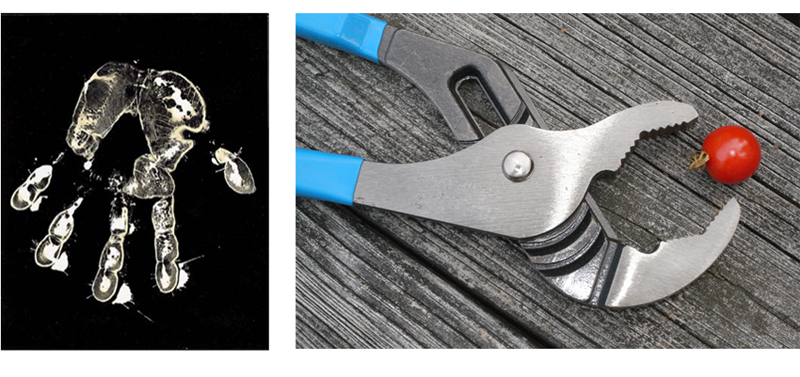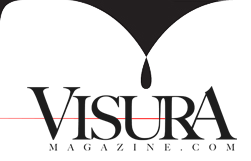
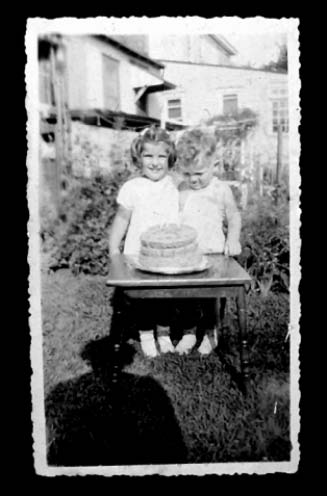 MY EARLIEST BRUSH with photography came when I was three. My best friend and everyday playmate was having a birthday party and her cake, the biggest I had ever seen, was displayed on a small table. It was a chocolate cake with vanilla icing. The photographer, a mother or grandmother, told us to stand behind the cake for a picture. We did. Then she told us to kiss. Well, we weren’t into that, but my friend put her arm around me and I acquired a lifelong love of chocolate cake … with vanilla icing. I learned that pictures can make people laugh. Maybe somehow, I also learned that pictures can hint at what’s happening inside a person, as well as showing their surface. In my memory, the shadow was much larger and more ominous. So finding a copy of the picture taught that memories are tricky. But I’m still not so keen about posing pictures.
MY EARLIEST BRUSH with photography came when I was three. My best friend and everyday playmate was having a birthday party and her cake, the biggest I had ever seen, was displayed on a small table. It was a chocolate cake with vanilla icing. The photographer, a mother or grandmother, told us to stand behind the cake for a picture. We did. Then she told us to kiss. Well, we weren’t into that, but my friend put her arm around me and I acquired a lifelong love of chocolate cake … with vanilla icing. I learned that pictures can make people laugh. Maybe somehow, I also learned that pictures can hint at what’s happening inside a person, as well as showing their surface. In my memory, the shadow was much larger and more ominous. So finding a copy of the picture taught that memories are tricky. But I’m still not so keen about posing pictures.
1942: I was born nearsighted, myopic. Everything was a blur, without detail. I didn’t know there was anything unusual about this; I thought it was that way for everyone.
This made every day an adventure. Wow, is that a bear coming in the front door? Ah, no, just mom in her fur coat. Each moment was full of possibilities, sometimes terrifying. Was that shadow moving onto my bedroom window a gorilla? Or a tree? I had to figure out what was actually going on.
This was during the late, depression thirties and early War forties. At that time in New York, there were seven newspapers and on Sundays, six had “comics.” Mayor Laguardia, a short, burly man with a deep, New York accent, would read the 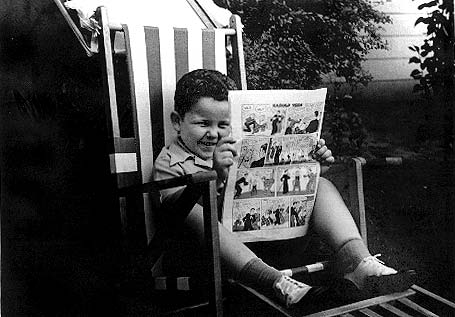 comics with great animation over the radio so kids who couldn’t read yet or whose families could only take one paper could keep up with the adventures of Superman or Wonder Woman, Popeye or Buck Rogers. Donald Duck wasn’t bad either.
comics with great animation over the radio so kids who couldn’t read yet or whose families could only take one paper could keep up with the adventures of Superman or Wonder Woman, Popeye or Buck Rogers. Donald Duck wasn’t bad either.
Also, the same papers had photos that riveted me. I could hold the paper close enough that everything was sharp—not fuzzy like what I saw around me. The world of those pictures, both the cartoons and the photos, was different from my suburban world. The people in the cartoons said and did things no one in my neighborhood said or did. The photographs were of cannons exploding, tanks rolling, men shooting, gangland murders. Nothing like that happened in Teaneck, New Jersey.
Ever since those days, pictures have held two kinds of magic for me. Some are a likeness of a time and place, credible at least to me. Others are like mirages. Their shapes and forms suggest things that weren’t there, a content different from their subject. Robots stalk the earth; up is down. They deal in smoke and mirrors, punch holes in walls. I can still reclaim the blurry possibilities of the world I lived in as a little boy.
Such pictures are like gifts from a buried self.
1945: Jacky McGahan
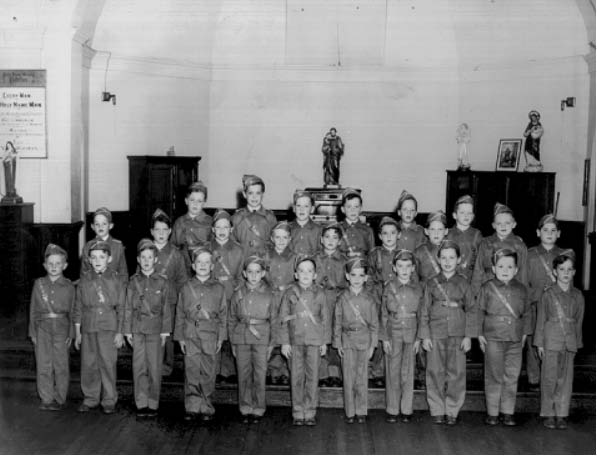 When I was a kid, one of the boys in my pack was Jacky McGahan. I’m second from the right in the bottom row. Jacky McGahan is at the righthand corner of the statue in the back. Jacky was impossible.
When I was a kid, one of the boys in my pack was Jacky McGahan. I’m second from the right in the bottom row. Jacky McGahan is at the righthand corner of the statue in the back. Jacky was impossible.
No matter what game of guns we played, Cops and Robbers, Cowboys and Indians, Nazis and Americans, Jacky would never play fair, would never die. You could hold a gun right to his head, go “Kapow” and as you walked away he’d jump up and yell “Ya missed. Ya missed.”
One day, we were sitting on the front stoop and I got on to Jacky about why he did this and he said, Ya know, I’m actually Superboy. Bullets bounce off me. I can even fly.
Oh baloney, you can’t fly.
I can too. I’ll show you. He stood on the top step, spread his arms and jumped in the air, shouting Superman’s formula: Up, up and away! Then, as he started to fall, he yelled Down!
Are you kidding? You didn’t fly. All you did was jump off the stoop.
Prove it, he said. Impossible.
1947: Magic, Fool the eye, sleight of hand
The dapper Father Quigley and his homburg hat met me as the magician, Tubrah Selrahc in a presentation by the nuns of St. Anastasia’s parochial school. I had a trick where I broke an egg into a hat, poured in milk and sugar, 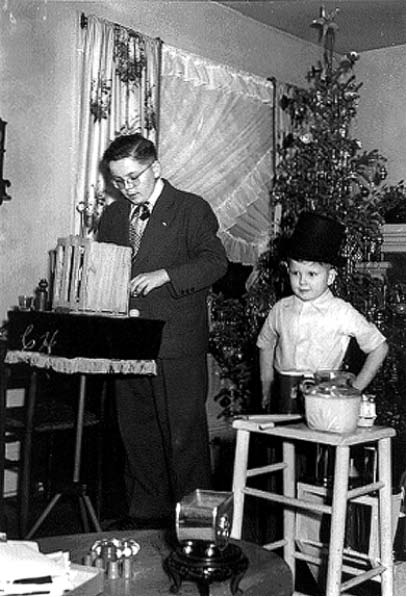 sifted in flour and dropped in a cube of chocolate. When the egg went into his (borrowed by the nuns) hamburg, Father Quigley leapt out of seat yelling Stop.
sifted in flour and dropped in a cube of chocolate. When the egg went into his (borrowed by the nuns) hamburg, Father Quigley leapt out of seat yelling Stop.
The Mother Superior restrained him and I said presto and produced a chocolate cupcake. I’d never liked him. Anyway, I was going on to a Jesuit high school in the fall.
1951: At Regis, I started taking pictures for the Owl, the school newspaper. We were a boys’ school with a small enrollment, but championship basketball teams. If you weren’t on the team, you had to go to the games and cheer. A friend took pictures for the school newspaper and that seemed more fun than cheering so I asked him to show me how.
This was before photography went to school; we had a darkroom, but no instruction. The school taught the classics: Greek and Latin, English literature, French and German, the Liberal arts for gentlemen citizens, not the Servile, for slaves who might get their fingernails dirty making the visual arts. To learn more about how to develop and print pictures, I went to the local camera club. They told me just expose the film the way it says on the box, mix the chemicals the way it says on the cans and always remember, put stuff in the developer first, the hypo second. That has been my complete technical education.
It was also where I first saw an adult female nude … actually any female nude. I started to think photography might be an okay way to spend my life: museum visits, etc.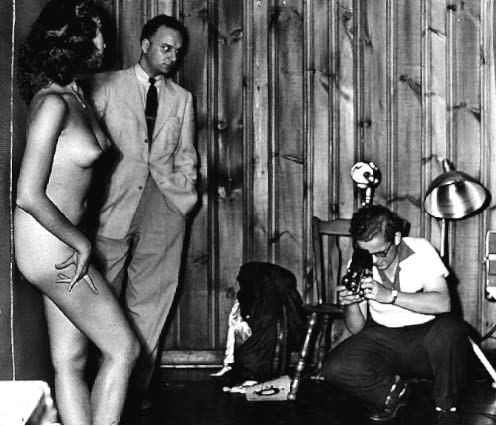
The high school had lots of rules. One was that only seniors could smoke on campus in the lounge/pool hall that rewarded their survival (only 25% of the entering class graduated). Underclassmen were forbidden to smoke on campus. The darkroom was hidden away on the top floor, off limits during recess except to my friend and me. We thought we could sneak smokes up there while making prints for the school paper. One day I was happily puffing away and there was a knock on the door. I doused my cigarette and opened the door. There stood the headmaster. I was suspended and sent home. I had forgotten the darkoom had an exhaust fan.
It was only noon and I wasn’t about to go home.
The school was near the Metropolitan Museum of Art, which is where I spent the afternoon. My punishment was to no longer be allowed to take pictures at the school. I knew I could do work in my coalbin darkroom at home. Somehow I realized that if an afternoon in a museum and an ineffectual prohibition were the worst the authorities could do, I needn’t fear them.
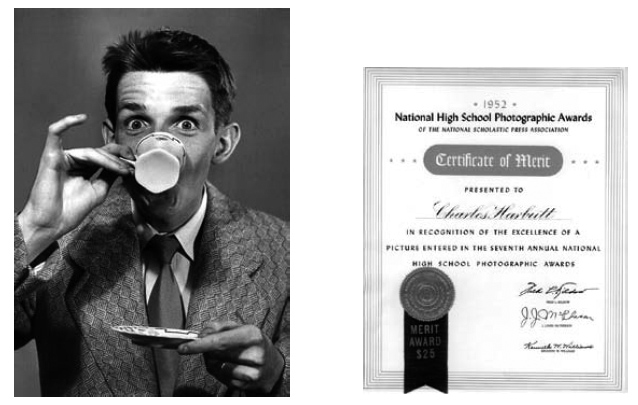
At the time, Kodak had a high-school photography contest and I decided my revenge would be to win. I won two prizes: one for this picture featuring the school comedian.
College
I liked working for the high school newspaper so much that I decided to study journalism. One of the best undergraduate courses was at Marquette, mainly because its Dean, Jerry O’Sullivan, had been a famous investigative reporter. He insisted on two things: that everyone learn everything about making a newspaper, from setting type and reporting to editing and layout and two: everyone should have a second major.
To my mind, I had left photography behind in high school, but the Dean came to me in my second semester and asked me to be the photographer for the school’s weekly newspaper. The actual photographer had been put on academic suspension. My reward would be a week off school.
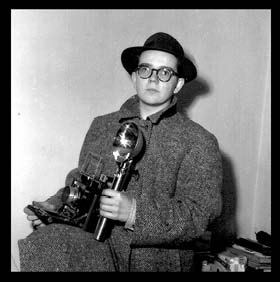
On one of my assignments I had met a young photographer for the Milwaukee Sentinel and he told me of a one-week documentary workshop at the University of Missouri, which would be taught that spring by Roy Stryker, the director of the famous Farm Security Administration photography project, and Russ Lee, one of its best photographers. We decided to go, but I only had the school’s press camera. My Sentinel friend found me a used Nikon rangefinder camera and off we went to Rolla, Missouri.
The way that course worked was that each of the twenty students shot some aspect of the county seat’s life. The film was processed and contact printed each day and the directors gave criticism and suggestions each evening before the whole group. My friend and I decided to do a paired study: he would photograph the daily life of the president of a shoe factory in town and I would cover the lowest worker on the payroll.
To my horror, my guy sat at his machine all day long, never cracked a smile or talked to anyone. He ate lunch squatting on the floor of the men’s toilet (there was no cafeteria). But he had nine kids at home and there he came alive, playing baseball with them or tag. He always seemed to have a kid hanging off his arm.

I asked to photograph the family at dinner and after a few worried looks, he and his wife agreed. We had squirrel stew. (Yes, like chicken.) I took this picture of a girl drying dishes under the fifteen watt bulb in the kitchen. Stryker, who had been a sociologist, picked it out to criticize. I should have used flash, he said, so that future researchers could count the silverware and identify the dress pattern and get other significant facts about the family. Russ Lee vehemently disagreed, saying, if I had used flash, I would have lost the actual mood of the kitchen and only been able to get one shot before the girl became self-conscious, aware of me and stilted. He argued that preserving the actual experience was what photography could do best. Leave counting teaspoons to the academics, he said. It was the first time anyone had ever stated a role for photography that meant something to me.
When I got back to college, I plunged back into photography and the Dean made sure I never lacked supplies. It was as good as an NEA grant. My favorite picture was like an inverse of the original snapshot.
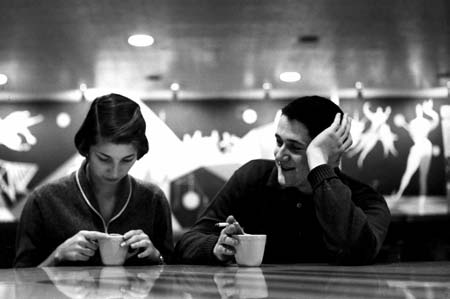
In my junior year, I made a picture that was published by the Milwaukee Journal, my first usage outside student newspapers, and I was hooked.
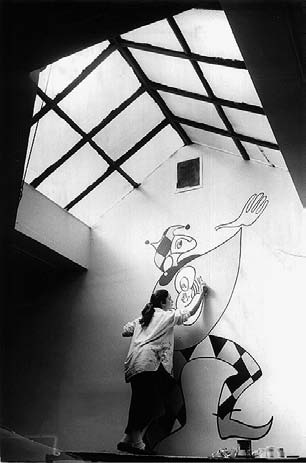 Marquette also had a good basketball team and I brought my portfolio to Life and Sports Illustrated, where I got the promise of stringer work, and to a new picture magazine called Jubilee, where I sold them on the idea that I would do pictures and text on the first week in America of a family on the last boatload of refugees displaced by the Second World War. I made my first cover for a national magazine and got the offer of a job there as writer/photographer after graduation.
Marquette also had a good basketball team and I brought my portfolio to Life and Sports Illustrated, where I got the promise of stringer work, and to a new picture magazine called Jubilee, where I sold them on the idea that I would do pictures and text on the first week in America of a family on the last boatload of refugees displaced by the Second World War. I made my first cover for a national magazine and got the offer of a job there as writer/photographer after graduation.
Goodbye to Words
As a year went by at Jubilee, I found myself doing more writing and editing and less photography.
One sweltering August day, I was writing the text and captions for another photographer’s story on winter in Japan. Drops of perspiration were falling dissolving the copy paper in my typewriter. I had never been to Japan. I realized that while this might be writing, it wasn’t journalism. To ensure that I actually experienced whatever I was communicating I would have to become a photographer full time; only they had to be physically present at what they reported.
I realize now that I’ve never grown up. I’m still trying to do what I’ve been doing all my life: trying to see what’s really going on in the world, including its mysteries and magic, its girls and chocolate cakes… with vanilla icing.
One last footnote,
Recently, when printing for a show, I realized I had never tested the camera club’s instructions to always put things in the developer first, the hypo second. So I decided to reverse the process to see what would happen. Instead of developing a picture I would suppress development to make one. I exposed a piece of photo paper to light, dipped my hand in hypo like a cave person and slapped it on the paper.
I really wanted to feel that slap. I’ve always thought that the prehistoric hand prints were our first efforts to have a thing itself make its own image, the essence of photography. Then I washed off the hypo and developed the print (that is the background). Unlike photograms, the detail was amazing: the print preserved the whorls of my finger and palm prints and even seemed to stop the action of slamming my palm down. Better yet, it looked like a predatory squid washed up in some prehistoric tidepool.
